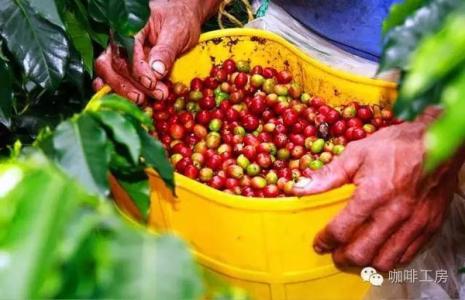Introduction to the production area of varieties with AA Flavor description and Grinding scale for Kenya Coffee Bean treatment
Kenya Coffee Bean Processing AA Flavor Description Grind Scale Variety Introduction
Don't underestimate Kenya's small farmers. They are no different from ants and soldiers. Their overall productivity is higher than that of large farms, about six to four, which is quite rare in soybean producing countries. Kenyan coffee is widely appreciated by connoisseurs, thanks in large part to smallholder farmers who work hard to grow good coffee in the foothills. In addition, Kenya beans must have a strict classification system, washing plant coffee beans, according to size, shape and hardness, divided into five grades, the highest level is PB, followed by AA++, AA+, AB. This grading system is similar to Colombia, mainly based on particle size and shape considerations, but good selling is not good flavor. This is what coffee fans should know. The current international evaluation of Kenyan beans is not as good as in previous years. I believe this has something to do with the abnormal climate and unfavorable coffee growth, but things are not so simple.
Arabica trees were introduced by missionaries from Yemen in the 19th century, but they were not cultivated in large numbers until 1893, when the old Brazilian bourbon seeds were introduced. That is to say, the present Kenyan coffee has Brazilian ancestry, but the Kenyan bean flavor is very different from that of Brazilian beans due to differences in soil, climate and treatment methods.
Elevation, latitude, geology: the equator runs through Kenya, and the border is exactly within ten degrees of north and south latitude. It is a tropical region with two rainy seasons per year and two harvests, 60% concentrated in October to December and 40% in June to August. Coffee is mainly grown in volcanic areas around the capital Nairobi to the mountains of Kenya at an altitude of 1600 to 2100 meters. This height is suitable for coffee bean development flavor, because the mountain temperature is lower, the growth is slower, the aromatic components of coffee beans are fully developed, the fruit acid flavor is more obvious, and the texture is harder. This fertile, moon-shaped coffee zone is Kenya's main source of fine beans.
Kenya's northern neighbor is Ethiopia, where the Arabica coffee tree originated, but it was not until the early twentieth century that coffee cultivation began. In the 19th century, missionaries introduced Arabica trees from Yemen, but did not plant them in large quantities. It was not until 1893 that they introduced the ancient Brazilian bourbon coffee seeds to cultivate coffee on a large scale. In other words, Kenyan coffee has Brazilian ancestry. Due to differences in water, climate and processing methods, Kenyan beans have a completely different flavor from Brazilian beans. Brazilian coffee is grown at low altitudes, with soft texture and no obvious fruit acid flavor. Kenyan coffee trees, on the other hand, are concentrated on the slopes near Mount Kenya.

Important Notice :
前街咖啡 FrontStreet Coffee has moved to new addredd:
FrontStreet Coffee Address: 315,Donghua East Road,GuangZhou
Tel:020 38364473
- Prev

90 + Danqi Meng Coffee Bean varieties treated by description of taste and flavor
90 + Danqi Meng Coffee Bean Taste and Flavor description method 90 + is a vertically integrated coffee bean manufacturer with a very good reputation and reputation in the world, focusing on the production of boutique coffee, and committed to establishing a deep and long-term relationship with farmers. Since its establishment in 2007, it has frequently scored more than 90 points in Coffee Review, large and small coffee in the world.
- Next

Flavor description characteristics of Candle Coffee A brief introduction to the varieties of Grinding Calibration by Taste treatment
Flavor description characteristics of Candle Coffee 90 + does not refer to all coffee with a rating of more than 90 points. Good coffee, one year, one year. Sometimes haunt different manors, but also have different taste characteristics. Ninety + refers to a top range of coffee with 13 flavors. These coffees are only from American boutique coffee creator Ninety Plus.
Related
- Detailed explanation of Jadeite planting Land in Panamanian Jadeite Manor introduction to the grading system of Jadeite competitive bidding, Red bid, Green bid and Rose Summer
- Story of Coffee planting in Brenka region of Costa Rica Stonehenge Manor anaerobic heavy honey treatment of flavor mouth
- What's on the barrel of Blue Mountain Coffee beans?
- Can American coffee also pull flowers? How to use hot American style to pull out a good-looking pattern?
- Can you make a cold extract with coffee beans? What is the right proportion for cold-extracted coffee formula?
- Indonesian PWN Gold Mandrine Coffee Origin Features Flavor How to Chong? Mandolin coffee is American.
- A brief introduction to the flavor characteristics of Brazilian yellow bourbon coffee beans
- What is the effect of different water quality on the flavor of cold-extracted coffee? What kind of water is best for brewing coffee?
- Why do you think of Rose Summer whenever you mention Panamanian coffee?
- Introduction to the characteristics of authentic blue mountain coffee bean producing areas? What is the CIB Coffee Authority in Jamaica?

